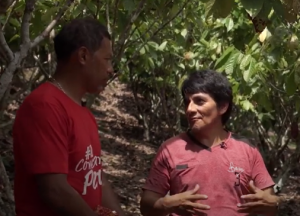
We often take for granted our access to technology. For people living in many countries, however, that luxury is often hard to come by.
William Tabera is a cocoa producer in Centroamérica, San Martín, Peru. His family plucks the fruit pods and processes the seeds inside. Until recently, Tabera’s village didn’t have cellular service or internet. Without that access, it’s been hard for Tabera to know how much his crop is worth.
“Traders, farmers, we all lack communication,” said Tabera. “[With the internet] we are now aware of the price of cocoa and the buyer can’t trick us anymore.”
Andesat has launched the #TeConectamosPerú campaign to promote this connectivity initiative.
The innovative Intelsat-Andesat partnership will allow for scaling of infrastructure and expertise to help build-out the integrated land-space 3G infrastructure, bandwidth capacity and service operations.
The plan is to connect 154 rural Peruvian communities, and as many as 400 remote sites in Peru over the next 18 months.
Peruvians are now celebrating the gift of modern communication.
“It will help us solve many things. Being aware of diseases, access to knowledge. We no longer feel left behind,” said Carlos Rengifo, a paramedic in Nuevo Trujillo. “We now have what other villages and cities do.”
Research shows that connectivity can have life-changing impacts for unconnected remote communities. The World Bank estimates that for every 10 percent increase in high-speed Internet connections, a country’s gross domestic product rises approximately by 1.4 percent.
“We’re thrilled to partner with Andesat to successfully pilot this innovation model and bring affordable, reliable connectivity to thousands of people throughout Peru,” said Intelsat Regional Vice President of Latin America Juan Pablo Cofino.
Increased communication can do many things, including ease a mother’s worried mind.
Matilde Bolivar’s daughter lives many towns away. Being able to call 
“We had never spoken like that before. Now I can see her face, I’ll no longer wonder if she’s ok or ill because I’ll be able to see her. It’s really nice,” said Bolivar.
To date, increased accesses to connectivity in remote areas of Peru has been deemed too risky for any one Mobile Network Operator (MNO) or communications service provider to tackle alone.
This collaboration model between Andesat and Intelsat can be replicated to help MNOs connect end-users in remote and rural areas throughout Latin America.
The Peruvian government alone has identified over 15,000 rural sites of National Interest that need connectivity.
“This initiative is going to change these people’s lives in a fundamental way. Not just to be able to communicate, but to be able to work better and improve their jobs and their businesses. It’s going to enable them to reach the world in a new and different way for the first time,” said Andesat Group CEO Pablo Rasore.
This is a concept not lost on William Tabera who says now he can see a brighter future for the next generation.
“We feel like modern up-to-date people. Communications and internet have arrived here at last. The future will prove easier for our children.”
For additional information on Andesat’s #TeConectamosPerú initiative, please visit www.teconectamosperu.com. Please click here for the English version.
To learn more about Intelsat’s commitment to connecting the unconnected, please visit the Connect More Resource Center.
Related Posts

Blog
Powering and Accelerating the True Virtualization of Space April 04, 2023



